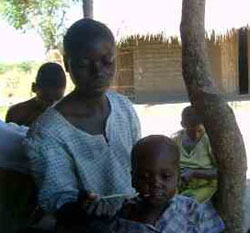You are here » Home » Telling Our Story
Success Story
Decentralized programs mean more locations
to serve more people
The Rainforests Can Remain Forever

Photo: Margaret Khonje/MSH
After being diagnosed by a local health center, Mwangodana can now be treated for her
malnutrition by her mother at home.
With local health centers now capable of delivering nutrition programs, nearly 75% of Salima District’s population has access to nutrition services, compared to 28% under the traditional approach.
Weak and suffering from malnutrition, 2-year-old Mwangodana came to her local health center with her mother. After reviewing her symptoms, the medical assistant immediately registered Mwangodana for the center’s outpatient therapeutic program (OTP) for malnutrition. Central Malawi’s Salima District, where Mwangodana lives, has some of the country’s highest rates of malnutrition. Luckily for Mwangodana, she and her family now have access to a therapeutic program in her community.
Malnutrition has been a challenge in Malawi for decades, but nutrition programs have traditionally been in hard-to-reach locations, requiring patients to be admitted for long periods of time. Today, with USAID support, nutrition programs have been decentralized to local health facilities, providing families with much greater access to care and treatment for malnutrition.
A USAID-supported implementing partner, in collaboration with district health management teams and local organizations, helped five districts decentralize their nutrition programs from one hospital location to 60 local health centers. Health staff at each location received updated training on how to identify cases of malnutrition, prioritize referrals based on need, and register children with severe malnutrition but no complications to an OTP that can be implemented at home. At each health center, parents now have access to up-to-date resources and instruction on how to treat malnutrition at home with Plumpy’Nut a ready-to-use peanut-based food fortified with essential vitamins, minerals, and fats.
In each health center providing OTP, the implementing partner provided staff training on how to examine and classify stages of malnutrition while educating and mobilizing communities to identify malnutrition early.
Subsequent follow-up visits to Mwangodana’s local health facility showed steady progress for her. With this new approach, nearly 75% of Salima District’s population has access to nutrition services, compared to 28% under the traditional approach. Mwangodana and over 4,800 more children have combated malnutrition thanks to programs like this.
Print-friendly version of this page (533kb - PDF)
Back to Top ^ | 

